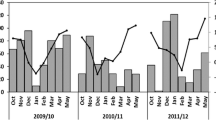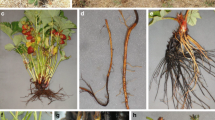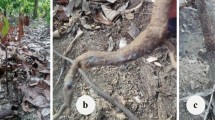Abstract
Cultivated gentian (Gentiana scabra var.buergeri) has been seriously damaged by pink root rot since the 1970s. Diseased plants finally collapse after wilting and stunting. More than 40 fungal genera were found to be associated with roots of mature and immature diseased plants or seeds. Among these fungi,Pyrenochaeta gentianicola sp. nov. andP. terrestris were almost always associated with the diseased plants. Their morphologies and temperature responses were compared, and their pathogenicity was also demonstrated by artificial inoculation tests.
Similar content being viewed by others
Literature cited
Farr, D. F., Bills, G. F., Chamuris, G. P. and Rossman, A. Y. 1989. “Fungi on plants and plant products in the United States,” APS Press, St. Paul. 1252 p.
Hansen, H. N. 1929. Etiology of the pink-root disease of onions. Phytopathology19: 691–704.
Hansen, H. N. 1938. The dual phenomenon in imperfect fungi. Mycologia30: 442–455.
Kreutzer, W. A. 1941. Host-parasite relationships in pink root rot ofAllium cepa. II. The action ofPhoma terrestris onAllium cepa and other hosts. Phytopathology31: 907–915.
Saccardo, P. A. 1884. “Sylloge fungorum,” Vol. 3, p. 120.
Schneider, R. 1976. Taxonomie der PyknidienpilzgattungPyrenochaeta. Ber. Deutsch. Bot. Ges.89: 504–514.
Sieber, T. N. 1995.Pyrenochaeta ligni-putridi sp. nov., a new coelomycete associated with butt rot ofPicea abies in Switzerland. Mycol. Res.99: 274–276.
Sutton, B. C. 1980. “The Coelomycetes,” Commonwealth Mycol. Inst., Kew. 696 p.
Watanabe, T. 1992. A new species ofPyrenochaeta from Japanese black pine seeds. Trans. Mycol. Soc. Japan33: 21–24.
Watanabe, T. 1993. “Photomicrographs and illustrations of soil fungi,” p. 318. Soft Science Publications, Tokyo. (In Japanese.)
Watanabe, T. 1994. “Pictorial atlas of soil and seed fungi,” p. 335–336. Lewis Publishers, Boca Raton.
Watanabe, T. and Imamura S. 1977. Brown root rot (new disease) of gentian and the causal fungi,Pyrenochaeta species. Ann. Phytopathol. Soc. Japan43: 343 (Abstr. in Japanese.)
Author information
Authors and Affiliations
Additional information
Part of this work was conducted at the National Institute of Agricultural Sciences (presently National Institute of Agro-Environmental Sciences), Tsukuba S.C., Ibaraki 305, Japan by T. Watanabe.
About this article
Cite this article
Watanabe, T., Imamura, S. Pink root rot, a revised name of brown root rot of gentian, and the causal fungi,Pyrenochaeta gentianicola sp. nov. andP. terrestris in Japan. Mycoscience 36, 439–445 (1995). https://doi.org/10.1007/BF02268629
Accepted:
Issue Date:
DOI: https://doi.org/10.1007/BF02268629




